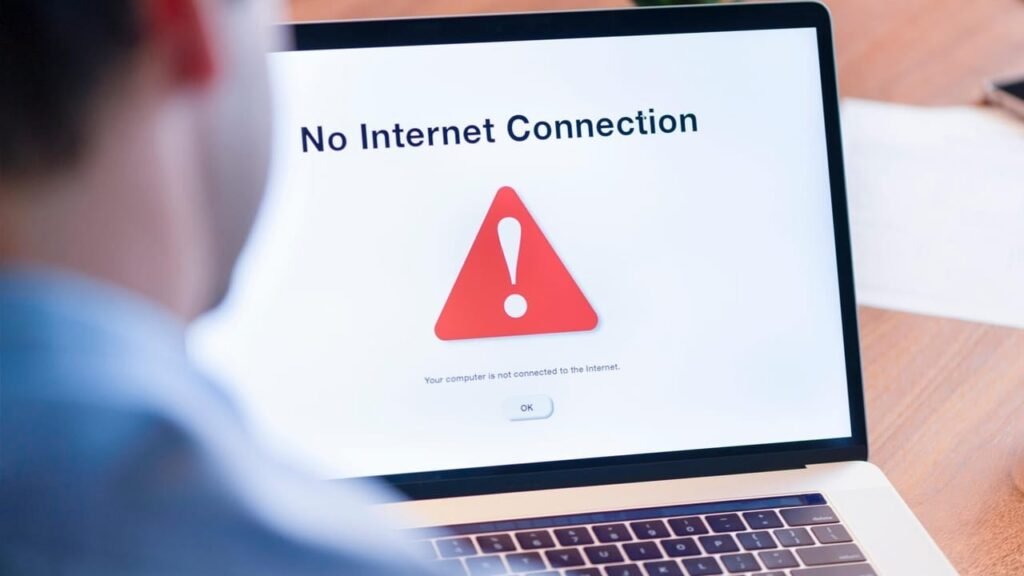Pakistan’s Internet Disruption: PTCL, PTA, and Government Tackle Submarine Cable Outage Amid Growing Public Pressure
In recent weeks, millions of internet users across Pakistan have been facing unusually slow internet speeds, intermittent connectivity, and performance lags — especially on popular apps like Facebook, WhatsApp, and Instagram. The cause of this widespread disruption is a fault in the AAE-1 (Asia Africa Europe-1) submarine cable system near Qatar, a critical undersea route that carries a substantial portion of Pakistan’s international internet traffic.
The Pakistan Telecommunication Company Limited (PTCL), one of the country’s major internet service providers, along with the Pakistan Telecommunication Authority (PTA), has confirmed the issue and is actively working toward a resolution. While some temporary relief has been provided, full restoration is still underway.
This situation not only highlights Pakistan’s dependence on undersea cables for international bandwidth but also reveals major vulnerabilities in the country’s digital infrastructure. As online services become increasingly essential for work, education, communication, and business, such disruptions have sparked public outcry, demands for accountability, and discussions on long-term technological resilience.
What Is the AAE-1 Submarine Cable and Why Is It Important?
The AAE-1 (Asia Africa Europe-1) submarine cable is one of the world’s largest and most advanced submarine cable systems. It connects Asia, the Middle East, East Africa, and Europe via an extensive network of undersea fiber optic cables. The system stretches over 25,000 kilometers and links more than 19 countries, including Pakistan, through multiple landing points.
Pakistan connects to this cable system through its landing station near Karachi. PTCL is the primary operator that manages the connection on behalf of the country. The AAE-1 cable plays a pivotal role in carrying international internet traffic, including voice, data, and multimedia services, for millions of Pakistani users.
A fault in this cable means a sudden reduction in Pakistan’s bandwidth capacity, causing a ripple effect on every service that relies on stable internet connections — from social media to banking systems, freelance work platforms to cloud computing, and video streaming to online education.
What Caused the Disruption?
Last week, PTA confirmed that the ongoing internet disruptions were the result of a technical fault in the AAE-1 submarine cable system near Qatar. Although the exact cause of the fault remains unclear, undersea cable issues typically stem from external factors like seabed movements, underwater construction, anchoring by ships, or even environmental stress due to deep-sea pressure.
Submarine cables are vital yet highly fragile infrastructure. Repairs involve complex underwater operations using specialized ships and equipment, often requiring days or even weeks depending on weather and sea conditions.
As of now, authorities have not disclosed when full repair work will be completed, but multiple steps have been taken to mitigate the issue in the meantime.
PTCL’s Response: Temporary Measures and Bandwidth Addition
PTCL has been at the forefront of managing this crisis. In a recent statement, the company shared that it has added extra bandwidth to partially offset the disruption. While internet speeds have improved for general browsing and video streaming, users are still reporting issues with Meta-owned platforms, especially during peak hours.
The reason lies in how bandwidth is allocated and rerouted during such events. While basic traffic can be shifted relatively easily, specific services like WhatsApp, Instagram, and Facebook often require stable, high-quality connections due to their reliance on real-time data and multimedia exchange.
Despite these challenges, PTCL has assured that it is working closely with international partners and domestic agencies to fully restore internet services. Engineers and system administrators have been monitoring the situation around the clock, adjusting routing policies and optimizing traffic paths to deliver maximum speed and stability under the current limitations.
PTA’s Intervention and National-Level Bandwidth Management
The Pakistan Telecommunication Authority (PTA) also stepped in swiftly. In coordination with PTCL, the authority announced the rerouting of an additional 200 gigabytes per second (Gbps) of internet traffic to alternative channels. Moreover, Federal Minister of IT and Telecommunications, Shaza Fatima Khawaja, revealed that 630 Gbps of disrupted traffic had already been successfully diverted.
These adjustments are critical because Pakistan’s digital demand has grown exponentially in recent years. From startups and IT exports to e-commerce and mobile banking, almost every sector now relies on uninterrupted internet.
The combined bandwidth rerouting of over 830 Gbps shows the scale of the challenge and the level of response required to maintain service continuity. However, despite these extensive efforts, the impact remains noticeable.
User Impact: Freelancers, Businesses, and Students Hit the Hardest
The disruption has had widespread consequences, with freelancers and remote workers among the most affected. Pakistan has over 1.5 million registered freelancers who depend on stable, high-speed internet to deliver services like graphic design, content writing, web development, and virtual assistance to clients abroad.
Many have reported missed deadlines, canceled Zoom meetings, and disrupted project workflows. On platforms like Fiverr, Upwork, and Freelancer.com, even a few minutes of delay can affect job ratings and future prospects.
Small and medium enterprises (SMEs) operating in e-commerce have also faced losses. Delayed order processing, failed transactions, and slow-loading websites have impacted customer experience, leading to reduced sales and negative reviews.
Students attending online classes or preparing for exams have encountered difficulty accessing educational content and platforms like Google Classroom, Coursera, and YouTube. Even government services, which increasingly rely on digital portals for taxation, registration, and public complaints, have faced slower response times.
Reliable Energy for Pakistani Homes Backup Power along with Livoltek 5kWh Lithium Battery
Read This Articals
Social Media Access Disrupted: Why Meta Apps Are Slower
Despite general improvements in internet speed, users continue to experience sluggish performance on Meta-related applications, particularly WhatsApp, Instagram, and Facebook. These platforms are crucial not only for personal communication but also for business promotions, influencer content, online sales, and live interactions.
The reason for the Meta-specific slowdown lies in server routing. Meta services are hosted on global Content Delivery Networks (CDNs) that rely on optimized paths through submarine cables. With the AAE-1 cable compromised, traffic to these CDNs is now being rerouted through less direct, and often congested, paths, resulting in increased latency and buffering.
Until the original routes are restored or better alternates are established, full-speed access to these services may remain limited during high-traffic hours, typically between 7 PM and 11 PM.
Public Reaction and Political Scrutiny
Frustration has been growing among the public, especially on platforms like Twitter (X), where users have expressed outrage, sarcasm, and criticism over the country’s digital preparedness. The hashtags #InternetDown, #PTCL, and #WhatsAppSlow have been trending intermittently.
Opposition parties and members of civil society have used the incident to question the government’s priorities. Many critics argue that in an age where internet access is equivalent to a basic utility, Pakistan cannot afford to be caught off guard by infrastructure failures.
In response, the Ministry of IT has promised greater transparency, faster recovery, and a thorough audit of existing submarine cable dependencies. A few lawmakers have even called for a national submarine cable policy, encouraging diversity in cable connections and reducing dependence on a single route.
The Bigger Picture: Pakistan’s Reliance on Submarine Cables
Pakistan is connected to the global internet via six submarine cable systems, including:
-
AAE-1
-
SEA-ME-WE 4
-
SEA-ME-WE 5
-
IMEWE
-
TWA-1
-
Silk Route Gateway
However, AAE-1 is among the most critical due to its modern infrastructure and high bandwidth capacity. When such a cable is compromised, a significant chunk of the country’s international data traffic is affected.
This event serves as a wake-up call regarding the single point of failure risk. Pakistan’s internet infrastructure still lacks sufficient redundancy and resilience against such events. Even though multiple cables exist, the distribution of load is not balanced, and contingency plans are often reactive rather than proactive.
What’s Being Done Now — and What Comes Next?
PTCL and PTA have both assured the public that a complete resolution is in progress. International partners are currently working to repair the damaged section of the AAE-1 cable. Once completed, traffic will return to its optimal path, restoring full speed and stability.
In parallel, PTA is exploring ways to:
-
Expand bandwidth supply from alternate undersea cables.
-
Encourage internet service providers (ISPs) to invest in satellite-based backup systems.
-
Upgrade domestic internet exchange points (IXPs) for better performance.
Furthermore, Minister Shaza Fatima Khawaja has stated that the government will soon initiate discussions with major telecom operators to enhance cable diversity, invest in local data centers, and improve national internet infrastructure policy.
Lessons Learned and the Way Forward
This incident has exposed significant gaps in Pakistan’s digital readiness. While the response has been relatively swift, the need for proactive infrastructure planning is evident. To prevent future disruptions of this scale, Pakistan must:
-
Increase Cable Diversity: Avoid relying too heavily on one or two cables. More landing stations and alternative routes must be secured.
Promote Public-Private Partnerships: Telecom firms, government agencies, and private tech firms need to collaborate on digital resilience planning.
-
Invest in Local Hosting and CDNs: Hosting more content locally can reduce dependence on international bandwidth and improve performance.
-
Develop a National Emergency Internet Plan: Like disaster recovery protocols, Pakistan should have a rapid-response framework for digital outages.
-
Educate Users About Network Loads: Greater awareness can help users avoid heavy app usage during peak hours during known outages.
Final Thoughts
Pakistan’s recent internet disruptions have laid bare the fragility of the systems we depend on daily. While PTCL and PTA have taken commendable steps to manage the crisis, the experience underscores a deeper need for robust, diversified, and future-ready internet infrastructure.
As the country progresses in digital adoption — with ambitions in freelancing, IT exports, e-commerce, and online education — ensuring uninterrupted, high-speed internet must become a national priority. This event may well serve as the catalyst for a long-overdue digital infrastructure revolution.




